- (2008) Volume 9, Issue 2
Giuseppe Garcea, Ashley R Dennison, Clare J Pattenden, Christopher P Neal, Christopher D Sutton, David P Berry
Department of Hepatobiliary and Pancreatic Surgery, The Leicester General Hospital. Leicester, United Kingdom
Received September 12th, 2007 - Accepted November 9th, 2007
Context Patients with resectable pancreatic cancer comprise a small subgroup of the overall population with the disease from around 15 to 20%, with nearly all patients dying from their disease within 7 years of surgery. In the light of such bleak statistics, data regarding what factors may influence outcome, following attempted curative resection is essential in order to optimise the treatment options for patients. Methods This review analysed all Englishlanguage publications using PubMed and Web of Science databases for studies detailing outcomes following resection for pancreatic ductal adenocarcinoma from 1980 to the present day. Main outcome measures The data examined from papers were post-operative mortalityrates, median survival, yearly survival rates and other factors which may have influenced long-term survival; such as patientdemographics, operative details and tumour characteristics (such as example tumour size, lymph node metastases and tumour differentiation). Results There has been significant improvement in post-operative mortality over the last decades with a modest improvement in long-term survival. With the exception of post-operative blood transfusion, tumour characteristics remain the only significant features influencing survival after pancreatic cancer surgery. Favourable prognostic factors include tumour size less than 2 cm, negative resection margin, lymph node negative tumours, well-differentiated tumours and absence of perineural or blood vessel invasion. Conclusion In light of these data, it could be reasoned that tumour size, on cross-sectional imaging, might be employed as means of selecting the most appropriate candidates for surgery, in cases where the risks of resection are high.
Lymph Nodes; Neoplasm Staging; Pancreatic Neoplasms; Surgery; Survival
Note Some references [19, 20, 22, 23, 25, 26, 27, 35, 36, 37, 39, 44, 48, 54, 55, 58, 59, 61, 63, 65, 68, 72, 73, 87, 88, 94, 96, 99, 104, 110, 111, 117, 119, 122, 125, 127, 128, 129, 130, 131, 132, 133, 134, 135, 136, 137, 138, 141, 143, 144, 145, 147, 148, 150, 151, 152] are not discussed fully in the text because the data presented in the studies were not of a format which would allow any further analysis, other than the calculation of postoperative mortality, overall long-term survival and median survival. These references (plus the majority of the other references in the review) were used to generate the median post-operative survival, mortality rate and 1-, 2-, 3-, and 5-year survival rates, reported at the beginning to the results section under the heading literature search.
Patients with resectable pancreatic cancer comprise a small subgroup of the overall population with the disease from around 15 to 20% [1]. The long term survival of patients is appalling, with nearly all patients dying from their disease within 7 years of surgery [2, 3, 4]. In the light of such bleak statistics, data regarding what factors may influence outcome, following attempted curative resection is essential in order to optimise the treatment options for patients.
This review analysed all English-language publications using PubMed and Web of Science databases for studies detailing outcomes following resection for pancreatic ductal adenocarcinoma, from 1980 to the present day. The data examined from papers were post-operative mortality rates, median survival, yearly survival rates and other factors which may have influenced long-term survival; such as patient demographics, operative details and tumour characteristics (such as tumour size, lymph node metastases and tumour differentiation). When feasible, data derived from survival curves was included in the analysis. All the information examined related to pancreatic ductal adenocarcinoma only. Manuscripts which did not offer a differential breakdown between ductal adenocarcinomas and other cancers, such as periampullary tumours, distal cholangiocarcinoma and pancreatic endocrine tumours, were excluded from the review. Studies which described only outcomes following major vessel resection and reconstruction in addition to pancreatic resections were also excluded.
Statistical analysis was undertaken using the Student’s t-test, Mann-Whitney and ANOVA with GraphPad Prism version 3.00 for Windows (GraphPad Software, San Diego, CA, USA). Where appropriate, a metaanalysis of data was undertaken using a random effects model with Comprehensive Meta-Analysis software (Biostat, Englewood, NJ, USA). Two-tailed P values than 0.05 were considered significant.
Literature Search
A total of 154 studies detailing outcomes following resection for 25,930 patients were included in the study. Due to variations in reporting and the number of studies published, a greater number of more recent studies were applicable for this study when compared to earlier publications. Per decade there were 74 studies from 2000 to the present day [5, 6, 7, 8, 9, 10, 11, 12, 13, 14, 15, 16, 17, 18, 19, 20, 21, 22, 23, 24, 25, 26, 27, 28, 29, 30, 31, 32, 33, 34, 35, 36, 37, 38, 39, 40, 41, 42, 43, 44, 45, 46, 47, 48, 49, 50, 51, 52, 53, 54, 55, 56, 57, 58, 59, 60, 61, 62, 63, 64, 65, 66, 67, 68, 69, 70, 71, 72, 73, 74, 75, 76, 77, 78], 52 studies from 1990 to 1999 [2, 3, 4, 79, 80, 81, 82, 83, 84, 85, 86, 87, 88, 89, 90, 91, 92, 93, 94, 95, 96, 97, 98, 99, 100, 101, 102, 103, 104, 105, 106, 107, 108, 109, 110, 111, 112, 113, 114, 115, 116, 117, 118, 119, 120, 121, 122, 123, 124, 125, 126, 127], 25 studies from 1980 to 1989 [128, 129, 130, 131, 132, 133, 134, 135, 136, 137, 138, 139, 140, 141, 142, 143, 144, 145, 146, 147, 148, 149, 150, 151, 152] and only 3 studies dating from before 1980 [153, 154, 155]. The median post-operative survival was 15.8 months with an operative mortality rate of 4.1%. The median one-year, two-year, threeyear and five-year survival rates across all studies (from all decades) were 63.3%, 36.0%, 22.5% and 12.0%, respectively.
Postoperative Mortality and Survival across the Decades
There has been a marked reduction in the post-operative mortality rate following pancreatic resection across the four decades examined by this review from being as high as 25% before 1980 to 2.9% from 2000 onwards (Figure 1) (P<0.001). This finding is reflected in single-institution reports examining post-operative mortality and the year of resection. Crucitti et al. observed a reduction in morbidity and mortality from 55.6% and 16.7% respectively to 20% and 6.7% across the time periods of 1981 to 1987 and 1993 to 1995 [85]. Yuen et al. found that their post-operative mortality fell from 10.7% from 1995 to 1997 to 2.3 from 1997 to 2000 [45].
Winter et al. [17] reported remarkably similar mortality rates in their series of 1,423 pancreatic resections, to those observed by us across all studies, 30% from the 1970s, 5% from the 1980s, 2% and 0% from the 1990s and 2000s respectively, although this data incorporates non-ductal adenocarcinoma resections. The decreased morality seen following resection is most likely to be a corollary of increasing specialisation, centralisation of “Hepatobiliary” and “Pancreatic” services to dedicated units and improved pre-operative and post-operative care.
In spite of this marked improvement in postoperative mortality, median survival following resection appears unchanged (Figure 1). However, cumulative 1-, 2-, 3- and 5-year survival across these time points show an increase in the number of 5-year survivors from 1990 onwards, when compared to pre- 1990 reported survival rates. The percentage of 5-year survivors reported from studies from after 1990 being significantly greater than those from before this time interval (P<0.001). Single-centre reports examining survival across decades, such as Yeo et al. [109], have reported an improved median survival (17.5 months versus 7.5 months, respectively ) and improved 1- and 3-year survival rates (64% and 36% versus 32% and 14%) from resections undertaken in 1990s compared with those from the 1970s. Other studies have found improved five year survival (11% versus no survivors) from resections undertaken in 1990s compared to those from the 1970s [56].
Impact of Centralisation of Services and High-Volume HPB Units
Seventeen papers examining the impact of centralisation and high-volume units on pancreatic cancer resection results were identified from 1997 to 2006. Interpretation of the results across these studies requires some caution since some studies have analysed their results based on the volume of patients referred or treated by each centre, with delineation being made between high-volume and low-volume centres. Other reports have merely classified centres as “teaching” or “non-teaching” hospitals or “university” hospitals.
The majority of these papers have individually found a lower post-operative mortality following resection in a high volume/teaching hospital when compared to low volume centres (median mortality across all studies 5.5% versus 11%, respectively). The data is summarised in Table 1 [16, 21, 38, 46, 47, 49, 57, 93, 113, 156, 157, 158, 159, 160, 161, 162, 163]. Since 1979 it has been proposed that surgical volume impacted on mortality [164] and that this inverse relationship between hospital volume and mortality is most marked for high-risk procedures such as pancreaticoduodenectomy [165]. These findings are consistent with this notion. A detailed systematic review of hospital volume and mortality for pancreatic resection undertaken by van Heek et al. found that mortality rates were as high as 16.5% in hospitals undertaking less than 5 pancreatic resections annually, compared to 3.5% in those doing 24 or more [166].
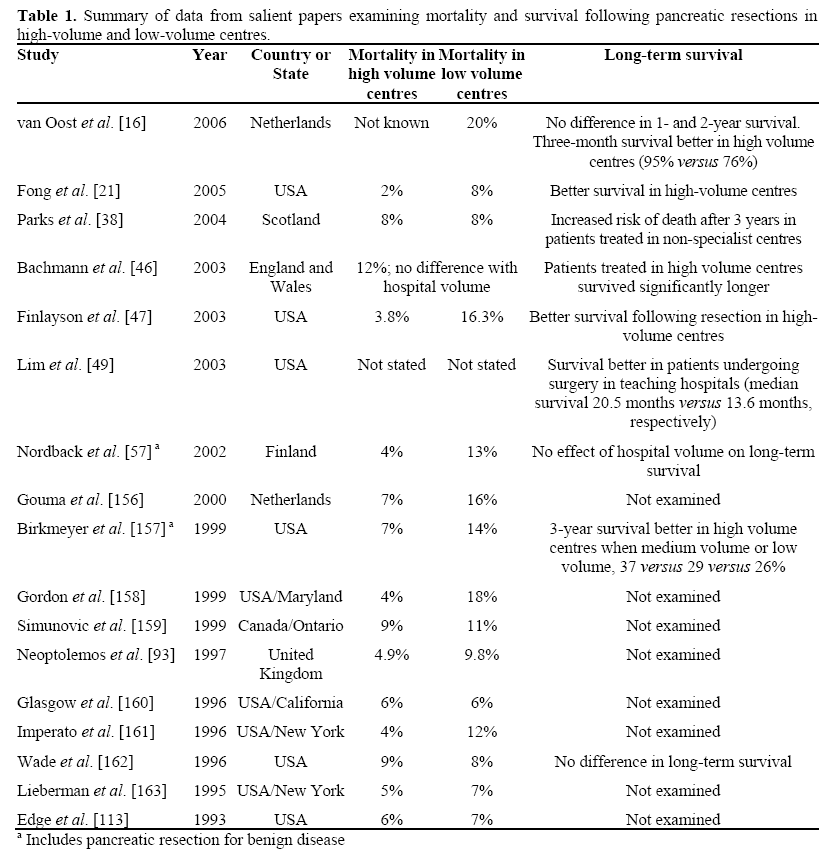
Although most of the earlier studies concentrated on variation in post-operative mortality and complications, more recent studies have examined the impact of highvolume centres on long-term survival following pancreatic resection. The data suggest that long-term survival is improved in hospitals with a higher volume (summarised in Table 1). In addition, treatment in specialist referral centres results in other benefits such as increased probability of resection, increased probability of pre-operative staging laparoscopy and increased probability of cytological confirmation of diagnosis [46].
Summary
In summary, there is clear evidence of improved post-operative mortality following pancreatic resection from 1970 to the present day. Whilst overall median survival has not changed, there is evidence of improved 5-year survival rates from 1990 onwards. Treatment in high volume specialist centres appears to result in a decrease in post-operative mortality and better long-term survival when compared to low-volume centres.
Gender, Age and Socioeconomic Status
There appears to have been little change in the demographics of patients undergoing resection of the pancreas for cancer over the years. The proportion of male gender patients and percentage of patients over 65 years of age, show no significant change over time [8, 13, 14, 30, 42, 43, 49, 50, 53, 66, 69, 70, 76, 80, 109, 114, 120, 124]. It is interesting to note that the proportion of elderly patients (i.e. aged over 65 years) does not appear to be increasing, in spite of significant improvements in the safety of pancreatic surgery over the same time period. There are reports of large series of pancreatic resections (n=287) of patients aged 80 or above years of age [167] which, in spite of slightly higher mortality rate than in younger patients (4.1% versus 1.7%), have shown that resections can be performed with a tolerable mortality in the very elderly. However, this approach does not appear to have been widely adopted.
Twenty-two studies reporting on age and survival following pancreatic cancer resection were identified. A summary of the pertinent findings is displayed in Table 2 [8, 13, 14, 32, 43, 49, 50, 53, 66, 69, 70, 75, 76, 78, 80, 105, 106, 109, 114, 116, 120, 168]. Only one study in the table found age to be a significant prognosticator for long-term survival [105], but the numbers in this study were relatively small. Another report examining resections from non-cystic epithelial pancreatic cancers (hence not included in the table) also concluded that patients aged over 74 years of age had a shorter median survival than those aged 65 to 74 years of age (11.4 months versus 25.1 months) [169].
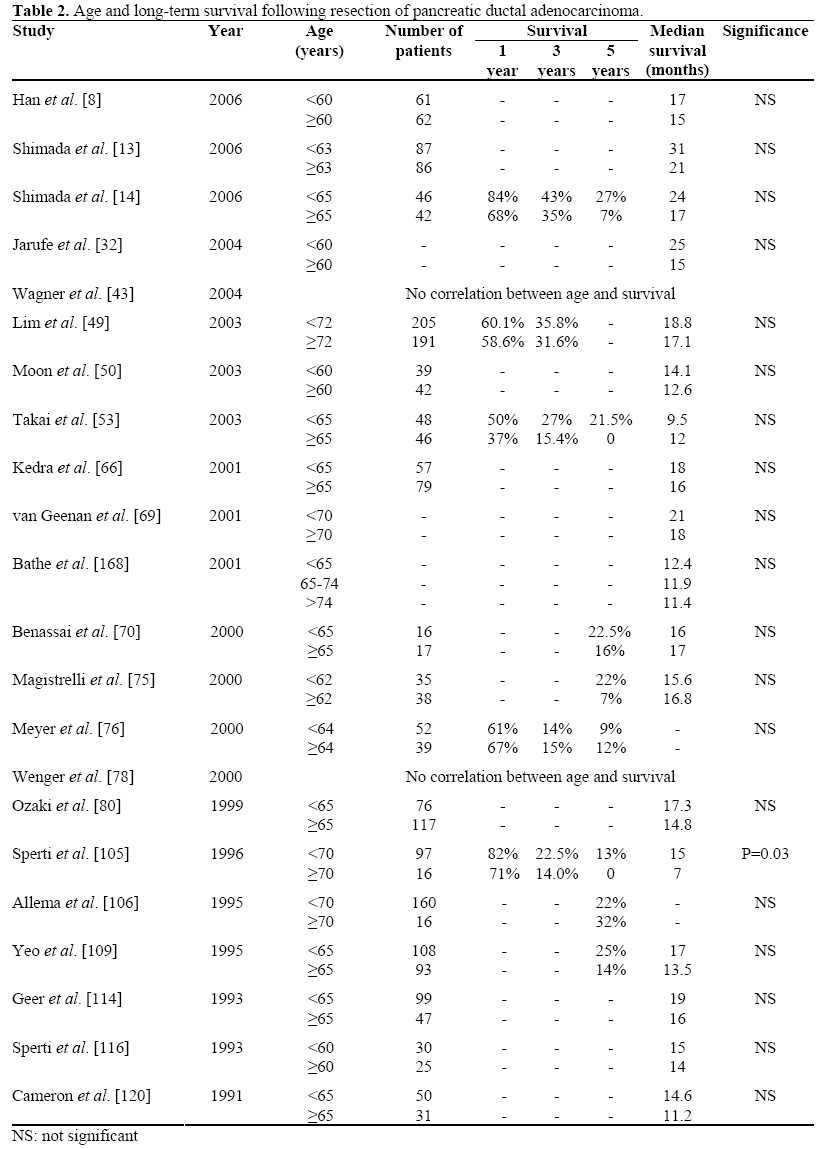
Twenty studies reporting on gender and survival were identified [8, 10, 13, 14, 30, 42, 43, 49, 53, 66, 69, 70, 76, 80, 106, 109, 114, 116, 120, 124]. None of these studies reported that gender was associated with any variation in survival.
Socioeconomic Status, Ethnicity and Survival
The separation of socioeconomic status from ethnicity particularly in some countries, such as the US, can be fraught with difficulty; therefore the two are probably best discussed together. There is a relative paucity of data regarding the impact of these factors on survival from resected pancreatic malignancy. A total of four studies were identified which examined the effect of race and socioeconomic status. Cress et al. and Yeo et al. found no effect of race on outcome following resection [6, 109]. However, Lim et al. observed a significantly shorter median survival between African American and non- African American (10.3 months versus 18.3 months, respectively) [49]. In addition, they reported a strong trend towards better survival in patients with a higher-than-average income, which become significant on multivariate analysis.
Population-based studies have shown that African American patients had a higher risk of presenting with advanced-stage disease and unresectable tumours with a lower probability of receiving chemotherapy and/or surgery. The exact impact of cultural attitudes and of healthcare influencing these findings is difficult to elucidate. For example, Elubeidi et al. found a greater proportion of African Americans refused their respective therapies when compared to their white counterparts [169].
Bathe et al. reported a median survival of only 11.4 months in Hispanics undergoing resection compared to 21.7 months in non- Hispanics (P=0.009) [64, 168]. The causes of this are not immediately clear, since Hispanic patients had the same rates of resection as non-Hispanics and presented with similarstage disease. These are interesting findings which would require robust investigation to determine if there is an independent relationship between outcome following resection and ethnicity, or whether the results observed are a complex interplay of racedependent expectations, financial status and provision of healthcare.
Summary
It appears unlikely that age or gender have any impact on survival following pancreatic resection, since the overwhelming majority of papers reviewed show no evidence of any prognostic value. Factors leading to ethnic or class disparity and survival following resection for pancreatic cancer warrant further work, but no firm conclusions can be made at this time.
Pre-Operative Haematology and Biochemistry
Tumour Markers
Ten studies examining various tumour markers and survival following resection for pancreatic adenocarcinoma were found, principally CA 19-9. Three studies relied on the post-operative progression of the tumour marker and outcome, and hence were not applicable for this review. The results of those excluded studies found that normalisation of the levels of CA 19-9 were associated with improved disease-free survival and better overall survival [170, 171, 172].
Of the remaining studies, huge variations exist between the cut-off points used for analysis from above or below 1,000 or 100. Combined with variations in data presentation and reporting, this precludes detailed analysis of the results. Table 3 provides a suitable overview [7, 8, 14, 40, 53, 173, 174]. Overall, the results are inconclusive with studies equally split between those finding tumour markers such as CA 19-9 able to predict outcome and those reporting no statistically significant association. It is probable that the trend in tumour marker value post-operatively is of greater value in predicting outcome rather than a single reading at the time of surgery. In addition, tumour markers are an index of tumour burden, hence many patients eligible for resection surgery have low tumour burdens and thus more sensitive indices of tumour volume are needed. Yamaguchi et al., for example, reported no significant difference in CA 19-9 or CEA values between patients with large or small tumours undergoing resection surgery [82] (this study did not present tumour marker data in the context of survival following resection and so was not included in Table 3).
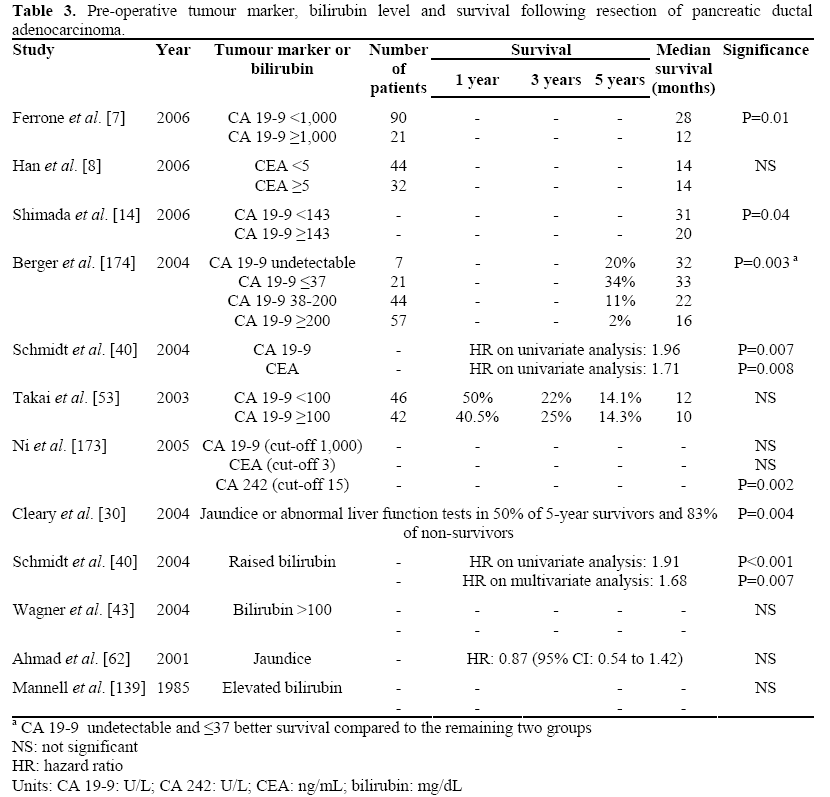
Bilirubin Level
With regards to long-term survival only two of the five studies reviewed reported a deleterious effect on survival in patients with a raised bilirubin (Table 3) [30, 40, 43, 62, 139]. Intuitively it is difficult to postulate how a raised bilirubin pre-operatively could impact on long-term survival following pancreaticoduodenectomy, except as an obtuse indicator of tumour size. Alternatively, peri-operative stenting may contribute to immediate postoperative mortality secondary to sepsis or impede oncological resection by obscuring tissue planes with oedema and inflammatory changes. There are few data to suggest that stenting per se increases risk following pancreaticoduodenectomy [175], particularly in the absence of positive bile cultures [176]. Although, data from small series do suggest that a raised bilirubin increases morbidity and mortality following surgery [146, 149].
C-Reactive Protein and Platelet Count
Other serum parameters examined in the context of long-term outcome following pancreaticoduodenectomy include C-reactive protein (CRP), glucose levels [40] and platelet count. There are too few studies to make a reasoned conclusion as to the validity of these findings, but the results are of interest and are discussed below. Jamieson et al. reported a median survival of 21.5 months in patients with a CRP of less than 10 versus a median survival 8.5 months in those patients with a CRP greater than this [24]. It is likely that CRP is a measure of tumour burden and indeed levels are significantly higher with increased tumour size and the degree of dedifferentiation [24].
Platelets are thought to interact with tumour cells and endothelial cells and to participate in both angiogenesis and haematological metastases. Platelets are also raised in inflammatory processes, such as those found with carcinogenesis. Hence, increased platelets could correlate with survival as a function of tumour burden and metastatic potential. Two English-language papers have reported significantly lower survival in patients with a thrombocytosis. Brown et al. reported a median survival of 18.6 months in patients with platelets below 300 x109/L and 11.2 months with platelets above 300 x109/L (P=0.034 on univariate analysis and P=0.007 on multivariate analysis) [18]. Suzuki et al. found that a thrombocytosis with platelets of over 400 x109/L was associated with diseasefree survival of 4.9 months versus 46.5 months in those with a normalised platelet count [41]. These findings merit further investigation and validation.
Summary
It is likely that serum tumour markers are not sufficiently sensitive to accurately predict prognosis at the time of resection, although serial post-operative markers may be more exact. There is evidence that pre-operative bilirubin levels, CRP and platelet counts may predict prognosis in a similar way to tumour markers, by serving as index of tumour burden and/or aggressiveness. There is emerging evidence that raised platelet counts and CRP could be strongly linked to adverse outcome, but more data is required.
Operation Duration
Five studies were found examining duration of operation with survival following pancreaticoduodenectomy [43, 53, 75, 109, 114]. No definite conclusions can be drawn from the data. It seems likely that duration of operation would be related, in some part, to tumour size and this could explain the observations from some studies that the period of surgery was associated with poorer survival. However, it is difficult to see how this data, if borne out by other studies, could be applied in a clinical setting in predicting or improving survival.
Blood Loss
Thirteen papers reported on intraoperative blood loss and transfusion requirements in pancreatic cancer resection (Table 4) [8, 40, 43, 49, 50, 53, 66, 75, 77, 105, 106, 114, 120]. The data presented varies from units transfused to actual blood loss intraoperatively, hence severely limiting the number of studies included in the metaanalysis. Studies included in the metaanalysis were those reporting median survival and yearly survival for the cut-off points of less than 2 units or more than 2 units of blood transfused. Meta-analysis of 1-, 3- and 5-year survival data did not reveal a significant trend towards transfusion affecting survival (OR=0.84, 95% CI: 0.52-1.37; P=0.484) (Figure 2). However, on analysis of the median survival data, transfusion of less than 2 units was found to favour prolonged survival (OR=1.83, 95% CI: 1.04-3.24; P=0.037).
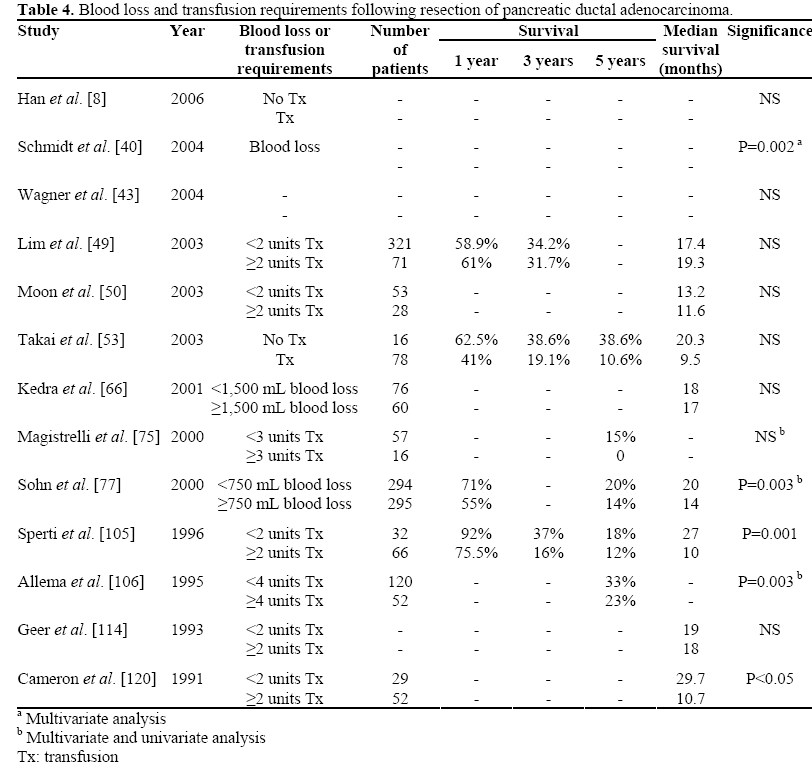
There are several possibilities on how intraoperative blood loss and blood transfusion may impact on long-term survival.
It is conceivable that technically difficult operations, due to large tumours or adherent tumours, will be accompanied by greater blood loss and hence post-operative transfusion requirements. However, three of the examined studies found that blood loss/transfusion requirements were independently prognostic [40, 105, 106]. Allogenic blood transfusions have been postulated to induce host immunosuppression, as evidenced by increased renal graft survival following transfusions [177, 178, 179]. This immunosuppression following cancer resections could result in increased probability of recurrence. A number of papers examining survival and blood transfusion for a wide range of oncological surgery have reported on this, although as yet it has not been definitively proved by a randomized controlled trial or meta analyses [180].
The nature of pancreatic surgery precludes the complete elimination of blood transfusion, although it would be prudent to minimise transfusion requirements, particularly in light of the data supporting the possibility of a deleterious impact on survival. There are various means by which this could be achieved, including a much higher threshold for transfusion, the use of white cell filters when transfusing, although this is a costly process without proven success [180], or the use of autologous blood transfusion. It must be stressed that a recent study of autologous versus allogenic blood transfusion, during colorectal cancer surgery, found no improvement in recurrence rates or survival [181].
Location of Tumour
There was wide variation in the homogeneity of data examining tumour location and survival, with some studies reporting on the type of resection i.e. distal pancreatectomy or pancreaticoduodenectomy (Table 5) [10, 14, 30, 43, 49, 66, 75, 77, 80, 97, 105, 107, 109, 116, 120, 124]. Furthermore, not all authors distinguished between distal pancreatectomies or pancreaticoduodenectomies, reporting between partial or total resections instead. In spite of this spectrum of data reporting, only one study found tumour location to be of significance in prognosis. It is of note that the same authors in a follow-up study several years later in a larger cohort of patients, no longer found that tumour location factored in survival following resection [105, 116].
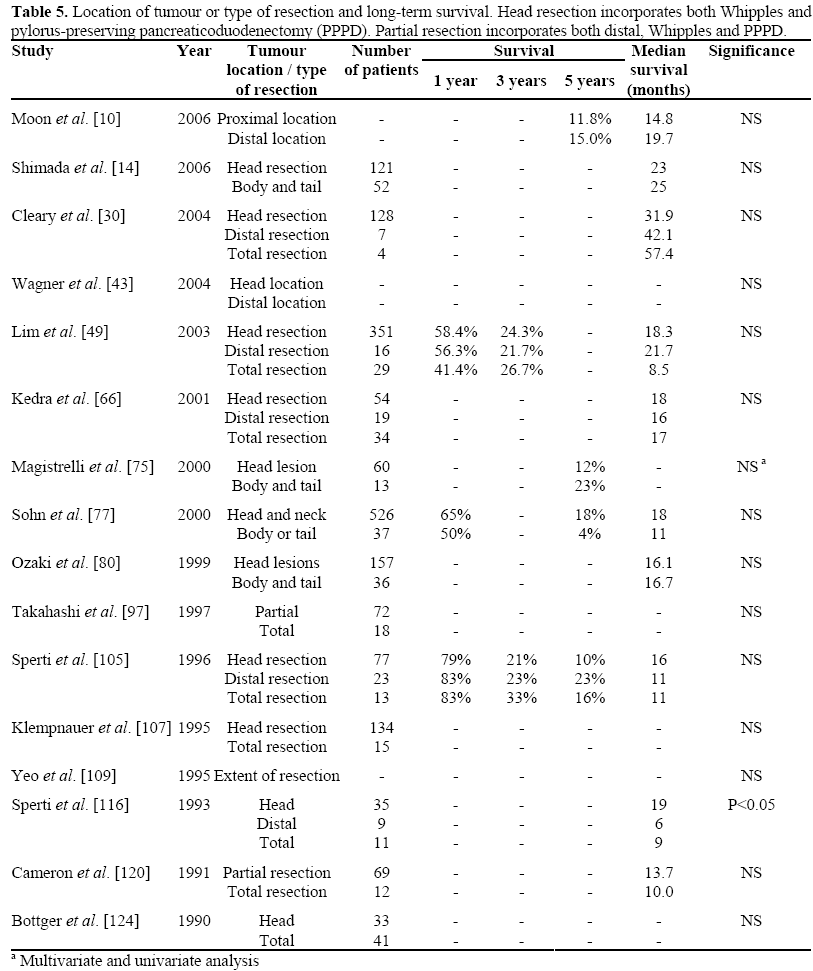
There are obvious risks to inferring where tumours are located according to the type of resection undertaken. However, it would be reasonable to assume that most recorded distal pancreatectomies would be undertaken for tumours located in the pancreatic tail, and most proximal pancreatectomies for those in the head. There is one further caveat to add to the assumption that location plays no part in outcome. Sohn et al. report significantly larger diameter in distally positioned tumours when compared to pancreatic head lesions (3.9 cm versus 3.0 cm, respectively [77]). A differential breakdown in tumours sizes was not available in the other papers reviewed. However, such a finding does raise the possibility that distal cancers have an equal survival to proximally placed cancers in spite of being larger at the time of resection. Despite these reservations, currently the evidence presented strongly suggests that tumour location is not a factor in long-term survival following ductal adenocarcinoma resection.
Summary
Duration of operation has been reported by some studies to relate to long-term survival following curative resection for pancreatic ductal adenocarcinoma, although no study has found this to be a significant prognosticator on multivariate analysis. Both intraoperative blood loss and units transfused have been found to predict long-term survival on univariate, multivariate analyses and metaanalysis. This finding could be multifactorial in nature, partly attributable to higher bloodloss operations being associated with bigger and larger cancers, and secondary to a transfusion mediated immune-suppression. Finally, the current evidence does not suggest that tumour location affects survival.
Tumour Size
Many studies reviewed did not report median tumour size for their series, instead reporting tumour sizes as greater or less than a fixed diameter. Figure 3 displays the proportions of tumour size resected from these studies. Those studies that report a median tumour diameter normally quote it as between 3.0 to 3.5 cm [15, 95].
Table 6 [3, 8, 10, 14, 17, 24, 31, 33, 43, 49, 50, 52, 53, 66, 70, 71, 75, 76, 77, 80, 82, 84, 91, 92, 97, 101, 105, 106, 107, 109, 112, 114, 116, 120, 123, 124] summarises data from all studies comparing tumour size with outcome following resection. It can be clearly seen that most studies report a significant association with tumour size and prognosis, on either multivariate or univariate analysis. Figure 4 summarises the median of the median survivals reported by the studies in Table 6 for varying cut-off points of tumour size. The data represented in this format strongly suggests that tumour size affects survival, with the greatest impact seen in resected tumours below 2 cm in size (35.5 months versus 14 months). Although it has to be noted that for larger tumour sizes the number of studies found were fewer, falling to just one study reporting median survival for tumours above or below 5 cm. Meta-analysis of yearly survival rates and median survival for tumours less than 2 cm or greater than 2 cm in size revealed that tumours less than 2 cm are associated with a better survival (OR=0.32, 95% CI: 0.18-0.56; P<0.001, and OR=2.52, 95% CI: 1.95-3.29; P<0.001, respectively) (Figure 5).
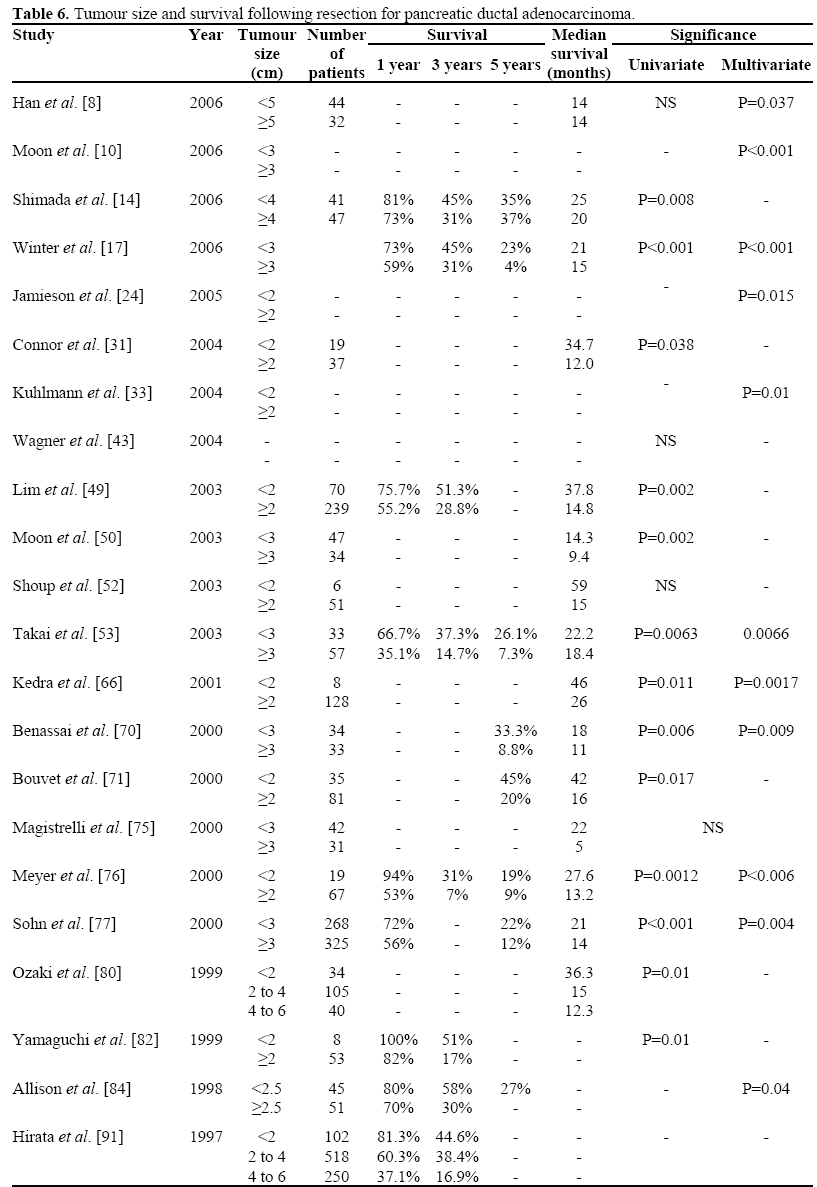
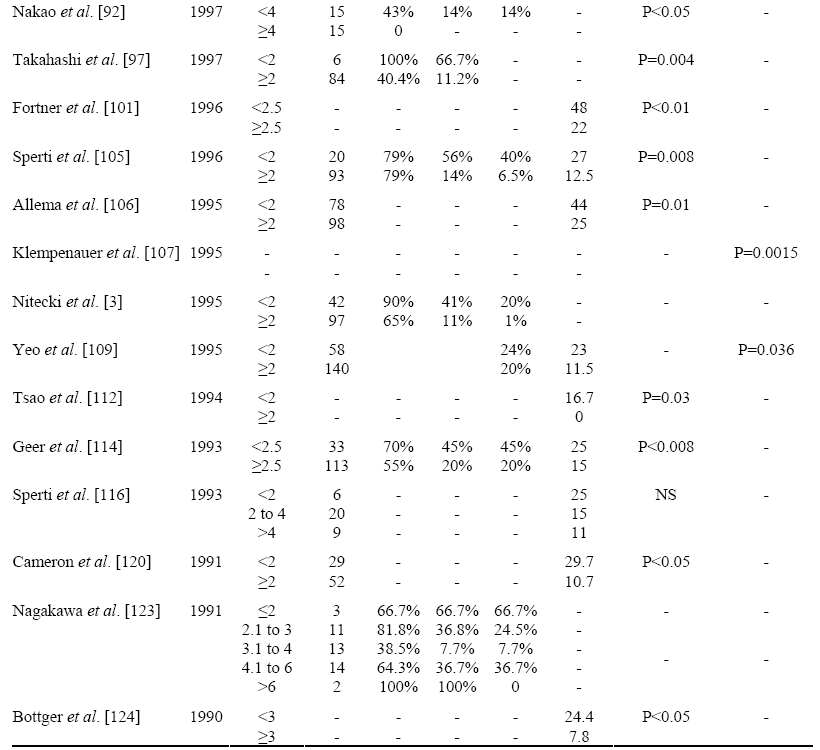
There are several possible ways by which larger tumours negatively impact on survival. The effect could be temporal in that larger tumours have an increased probability of micro-metastases and lymphatic spread at the time of surgery, due to their long-term presence. It may be that larger cancers reflect a more aggressive phenotype in fastergrowing de-differentiated tumours. Obtaining suitable oncological clearance with larger tumours could also contribute to decreased survival. However, the recent ESPAC data found that microscopic tumour involvement of the resection margin was not associated with tumour diameter [67]. There is evidence that tumours less than 2 cm in diameter have a greater probability of being clear of lymph node involvement, are better differentiated and have less perineural involvement than larger tumours [82]. Patterns of recurrence following pancreatic cancer resection also suggest that local recurrence is not the most common cause of death and that most deaths are secondary to systemic dissemination of disease, in the form of hepatic and lymphatic metastases [182]. This would suggest that tumour diameter determines survival by reflecting an aggressive tumour phenotype which is more likely to metastasise early, rather than comprising the resection margin at the time of surgery.
Since tumour size can often be reliably assessed on cross-sectional imaging, these findings are significant in radiologically predicting which patients should proceed with resection surgery. A tumour size of greater than 3 cm on pre-operative imaging demonstrated poorer survival after resection with a relative hazard of 3.8 [183]. For patients who represent poor candidates for resection surgery, due to low functional capacity or anaesthetic risk, tumour size on pre-operative staging could be an important
Lymph Node Status
A total of 51 studies detailing outcome and lymph node status were found and the data presented in Table 7 [3, 5, 7, 8, 13, 14, 15, 17, 18, 29, 30, 32, 33, 40, 42, 43, 49, 50, 52, 53, 60, 62, 66, 70, 71, 74, 75, 76, 77, 78, 80, 84, 91, 92, 95, 97, 100, 105, 106, 108, 109, 114, 115, 116, 118, 120, 123, 124, 140, 142, 168]. The median percentage of lymph node negative tumours was 42.4%, range from 11.4% to 72.0%. The majority of the studies reviewed concluded that lymph node status was a predictor of survival on either univariate or multivariate analysis. The median cross-study survival for lymph node negative patients (N0) was 25 months and 13.6 months for lymph node positive patients (N1). This difference was found to be highly significant on both parametric and nonparametric statistical analysis (P<0.001). A positive association of negative lymph node status on survival was further confirmed by meta-analysis of the median survival data (OR=2.09, 95% CI: 1.69-2.60; P<0.001) and yearly survival data (OR=0.32, 95% CI: 0.24- 0.42; P<0.001) displayed in Figure 6.
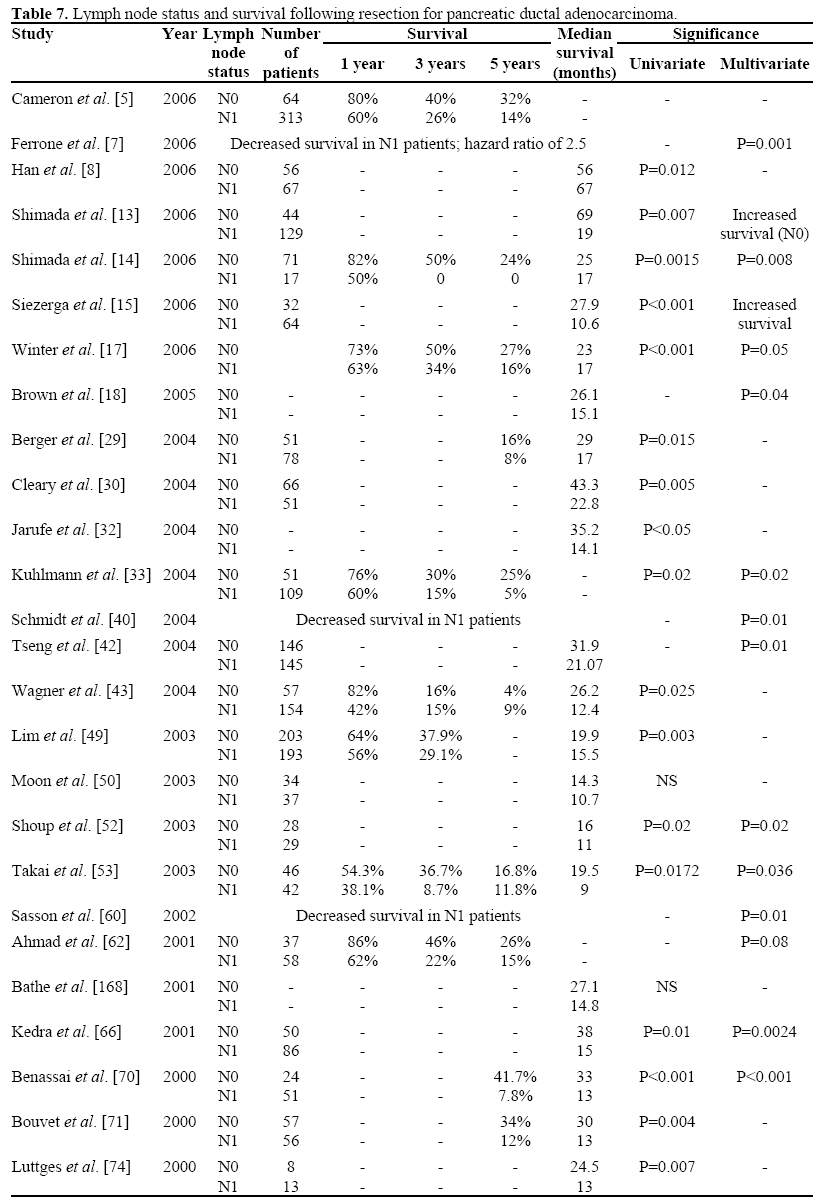
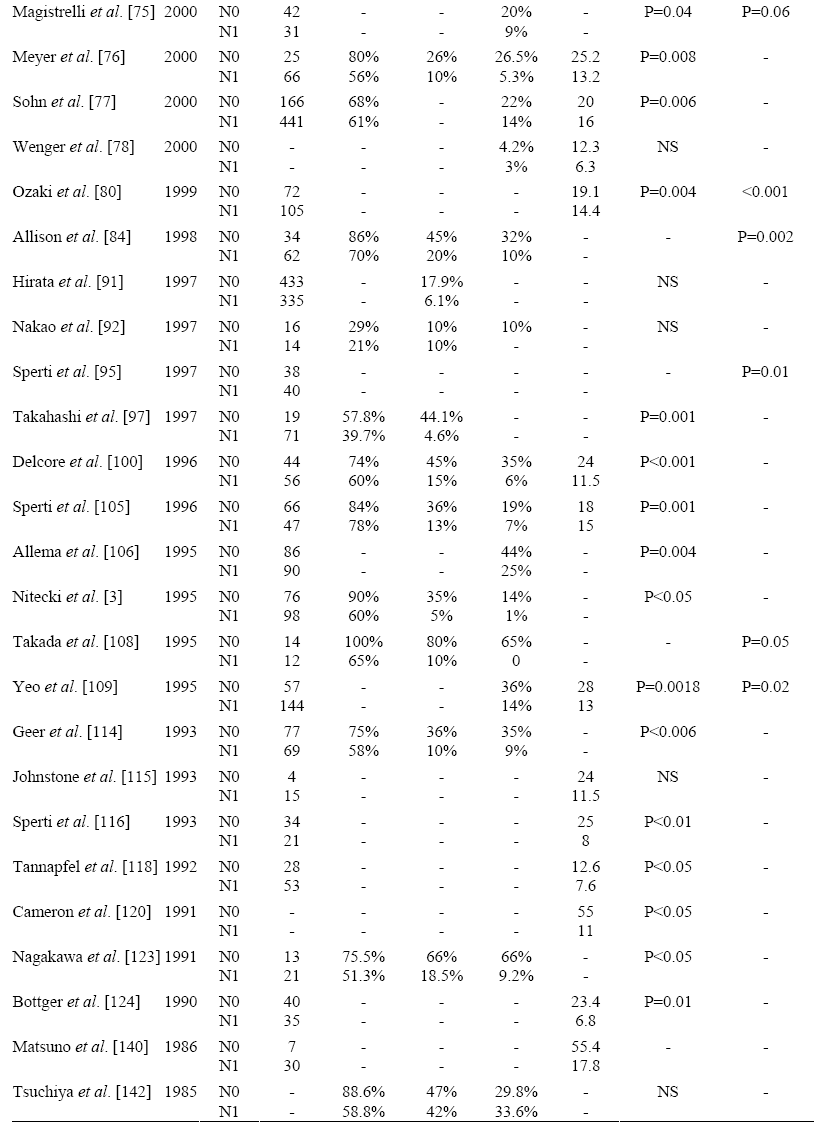
The data suggest that lymph node positivity is a major determinant of outcome following resection, a finding supported by the largest prospective series of prognostic factors (the ESPAC 1 trial) [67]. More recently, some studies have found that the ratio of involved lymph nodes to total lymph nodes harvested is a more accurate predictor of survival than lymph node status alone [15, 29]. These findings would suggest that outcome might be improved by removing more lymph nodes, by undertaking an extended lymphadenectomy.
Only two randomized controlled trials have examined the role of extended resections [83, 90]. Although, both studies demonstrated increased lymph node harvest in the extended resection arm (19.8 versus 13.3 and 28.5 versus 17), neither study found that this resulted in a survival advantage (median survival: 16.7 months versus 11.2 months and 20 months versus 21 months) for the respective studies. Pawlik et al. found that only 0.3% of patients would achieve a survival advantage following an extended lymphadenectomy [184]. The required sample size for a randomized trial suitably powered to detect such a difference would be too large to make it feasible. For such an aggressive cancer such as pancreatic ductal adenocarcinoma, a further consideration is that patients who have extensive lymph node involvement would have a high probability of concurrent hepatic micrometastases, thereby precluding them from benefiting from radical resections. At present, there is no evidence that extended lymphadenectomy has a role to play pancreatic cancer surgery.
Grade of Tumour
Thirty-six studies reporting on survival and tumour grade were reviewed and the results are summarised in Table 8 [8, 13, 14, 15, 17, 30, 31, 32, 33, 43, 49, 50, 52, 53, 66, 70, 71, 74, 75, 76, 77, 81, 89, 95, 97, 98, 105, 106, 107, 108, 114, 116, 118, 120, 124, 140]. In contrast to the data on lymph node status, there is not an overwhelming consensus confirming an adverse outcome with poorer tumour grade. However, the majority of papers reviewed reported a statistically significant association. Tumours which were well-differentiated at resection accounted for the smallest proportion of all cancers, with moderately-differentiated tumours responsible for the majority of all resected tumours. These ratios are to be interpreted with some caution, since there were far fewer papers displaying the number of moderately-differentiated tumours, with many papers choosing to group this category with either well-differentiated or poorly-differentiated tumours, presumably in an attempt to amplify any survival differences. Meta-analysis of median survival (OR=2.40, 95% CI: 1.69-3.41) and yearly survival (OR=0.26, 95% CI: 0.15-0.45) figures between well-differentiated and poorly differentiated tumours confirmed that well-differentiated tumours were associated with prolonged survival (P<0.001) (Figure 7). Tumour grade impacts on survival by serving as an index of the biological aggressiveness of the cancer. Data from ESPAC trial also confirms tumour grade and lymph node status being the only two independent prognosticators following pancreatic cancer resection. Unfortunately, apart from serving as an index of prognosis, tumour grade is unquantifiable pre-operatively and cannot be influenced by surgical technique or chemotherapy.
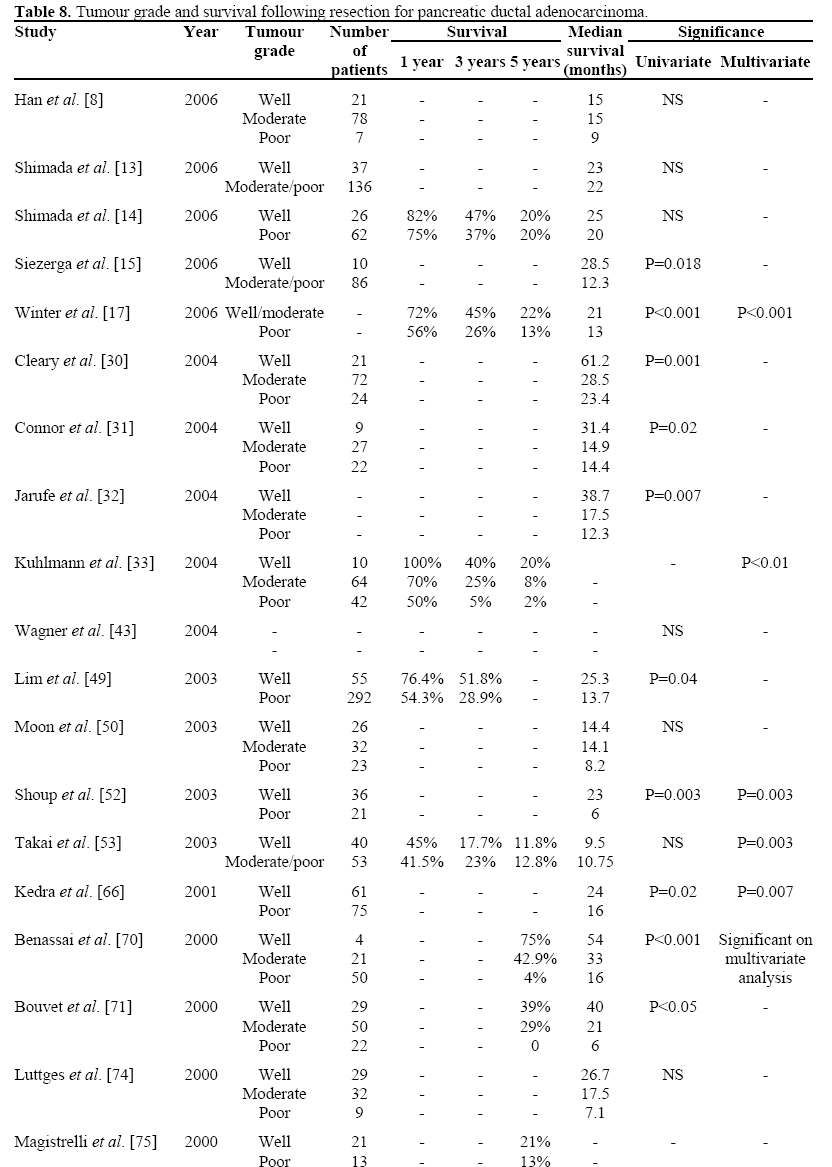

Perineural and Blood Vessel Invasion
Thirteen studies detailing outcomes for pancreatic cancers with perineural invasion were found and eleven studies for pancreatic cancers and blood vessel invasion. The summarised data is presented in Table 9 [13, 14, 30, 43, 71, 76, 80, 97, 105, 114, 116, 120, 124] and Table 10 [13, 15, 30, 43, 66, 71, 74, 76, 80, 105, 120]. The majority of studies reviewed determined that blood vessel invasion was associated with poor outcome, predominantly on univariate analysis. Just over half of the studies examining perineural infiltration reported it as a significant prognostic variable for survival. The crossstudy median value for tumours without perineural invasion was 62.1% (12 studies) and tumours with no blood vessel invasion was 83.8% (9 studies). Cross-study median values for survival were 16 months versus 18.4 months for tumours with and without perineural infiltration, respectively, and 11.9 months versus 20.6 months for tumours with and without blood vessel invasion, respectively. Neither groups achieved statistical significance on simple parametric and non-parametric analysis. Meta-analysis of yearly survival data for perineural invasion did not achieve statistical significance (OR=0.53, 95% CI: 0.16-1.74, P=0.296), however the median survival data did (OR=2.37, 95% CI: 1.77-3.18, P<0.001). A similar finding was seen with blood vessel invasion with yearly survival data failing to show a significant survival advantage with no blood vessel invasion (OR=0.58, 95% CI: 0.26-1.31, P=0.191), which was found to be approaching significance following analysis of median survival data (OR=1.88, 95% CI: 0.89-3.49, P=0.097, respectively).
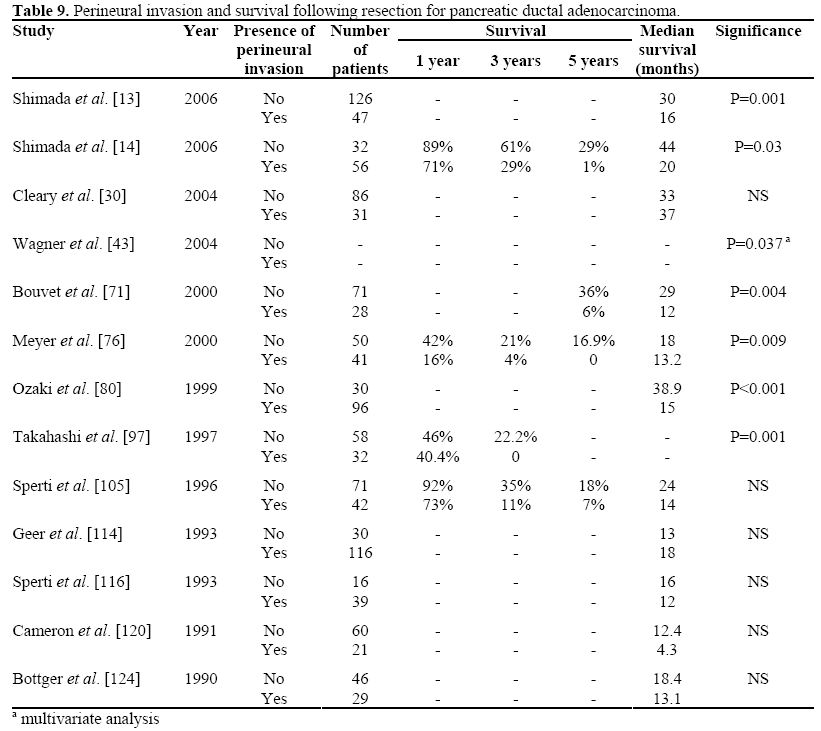
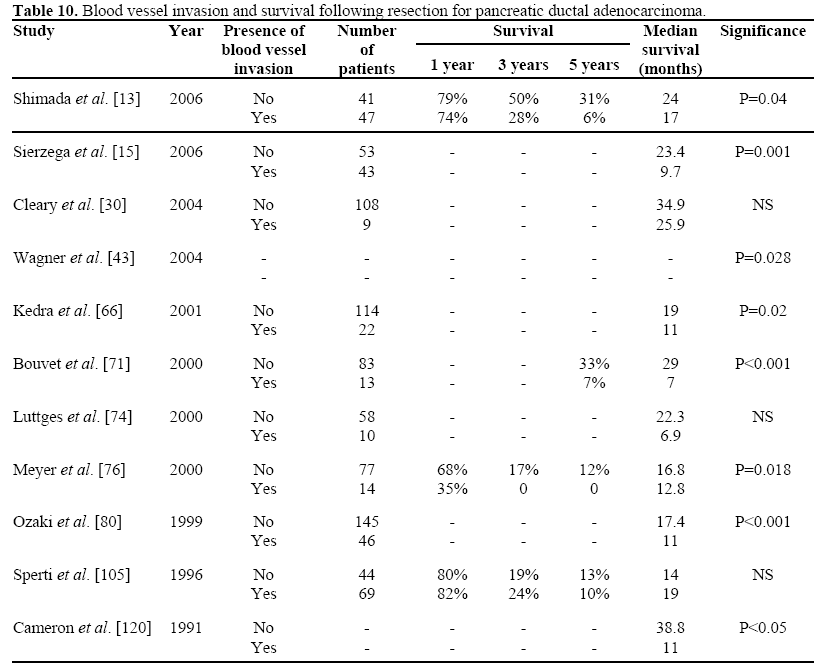
Micro-invasion of perineural and vascular tissue reflects an aggressive cancer phenotype. Perineural invasion, in particular, is regarded as a factor associated in local recurrence of pancreatic cancer and is associated with increasing de-differentiation of pancreatic tumours [185]. Pancreatic tissue hosts a large number of neural tissue and gangliae and is in close physical approximation to neural plexi in the retroperitoneum. It is, therefore, probable that perineural infiltration accounts for the main mechanism by which pancreatic cancers infiltrate the retroperitoneum. Data available only in abstract form by Pour et al. reported the presence of perineural infiltration in two tumours measuring only 2 and 4 mm in diameter [186], suggesting that perineural infiltration may be a very early event in pancreatic carcinogenesis. However, our finding that up to 63% of resected cancers were free of perineural infiltration would suggest otherwise. Despite microvessel invasion apparently being a less common finding (83% of resected cancers did not present with blood vessel invasion) the findings from Table 10 suggest that a greater proportion of the reviewed papers found it to impact deleteriously on survival when compared to perineural infiltration. This may be a consequence of the fact that although local recurrence is common following pancreatic cancer resection, it has been previously shown not to be a direct cause of death in contrast to lymphatic and hepatic metastatic disease [182]. So, whilst perineural invasion is more common and possibly an early event, microvessel invasion would lead to earlier haematogenous dissemination of disease and hence a have greater impact on survival.
Assessment of the clinical significance of major vessel invasion was problematic, since many studies detailing these results were papers reporting their series of venous resections. These papers were on the authors’ database since they also incorporated survival data for non-vascular pancreatic resections. Since, many centres would deem encasement of a major vessel a sign of inoperability, these data were not available from such papers, although many surgeons would be prepared to take a sleeve of portal vein to achieve a clear resection margin. These considerations may explain the skewed data presented in Table 11 [10, 14, 24, 30, 32, 42, 50, 80, 92, 97, 102, 105, 106], with many studies finding no significant impact on long-term survival. An adequate review of the risk-benefits of major venous resection and reconstruction in pancreatic cancer surgery is not the purpose of this paper. Only two papers were found detailing survival and duodenal invasion, whose findings are clearly at odds with each other, precluding any reasoned conclusion [10, 30].
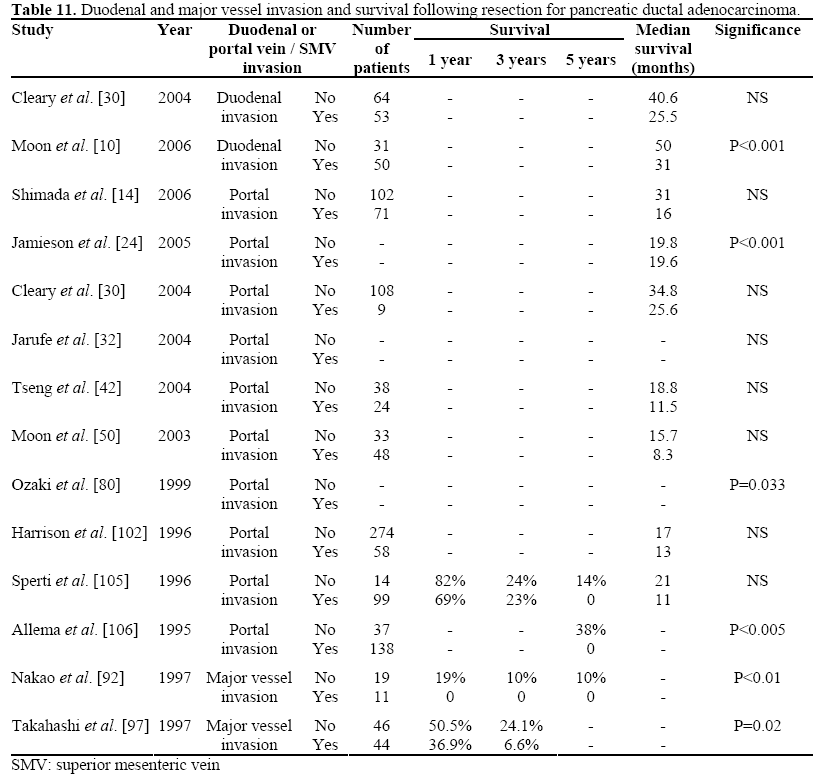
Resection Margin
For most oncological resections histological involvement by tumour at the resection margin would be defined as non-curative operation, however, as the data in Table 12 [3, 5, 8, 10, 13, 14, 15, 17, 18, 28, 30, 31, 32, 33, 42, 43, 50, 51, 52, 53, 60, 70, 71, 74, 75, 77, 78, 79, 92, 97, 106, 108, 109, 114, 120, 126] shows some patients with R1 resections do survive to 5 years following their surgery. In addition, whilst survival following R1 resections is poor, it appears equivalent to survival associated with other deleterious factors. The median cross-study survival for R1 resections was 10.3 months (versus 20.3 months for R0 margins), as compared to 13.6 months for lymph node positive patients, 10.5 months for poorly differentiated tumours and 13 months for tumours greater than 3 cm in diameter. Clearly then, whilst positive resection margins would appear to impact negatively on survival, with the majority of the 35 reviewed studies confirming this on univariate or multivariate analysis, it is not necessarily equivalent to a palliative procedure. Six of the studies reviewed found that resection margins were not significantly associated with any decrease in survival [30, 31, 42, 52, 75, 114]. This observation is supported by the ESPAC data, which demonstrated resection margin to an independent risk factor for survival only in the absence of tumour grade or nodal status [67]. Indeed, our cross-study median survival of 10.3 months for R1 resections is very similar to the ESPAC’s group prospectively collected survival value of 10.9 months. Meta-analysis of median survival data (OR=3.00, 95% CI: 2.15-4.17, P<0.001)and yearly survival (OR=0.26, 95% CI: 0.16-0.42, P<0.001) both showed a strong survival advantage associated with a negative resection margin (Figure 8).
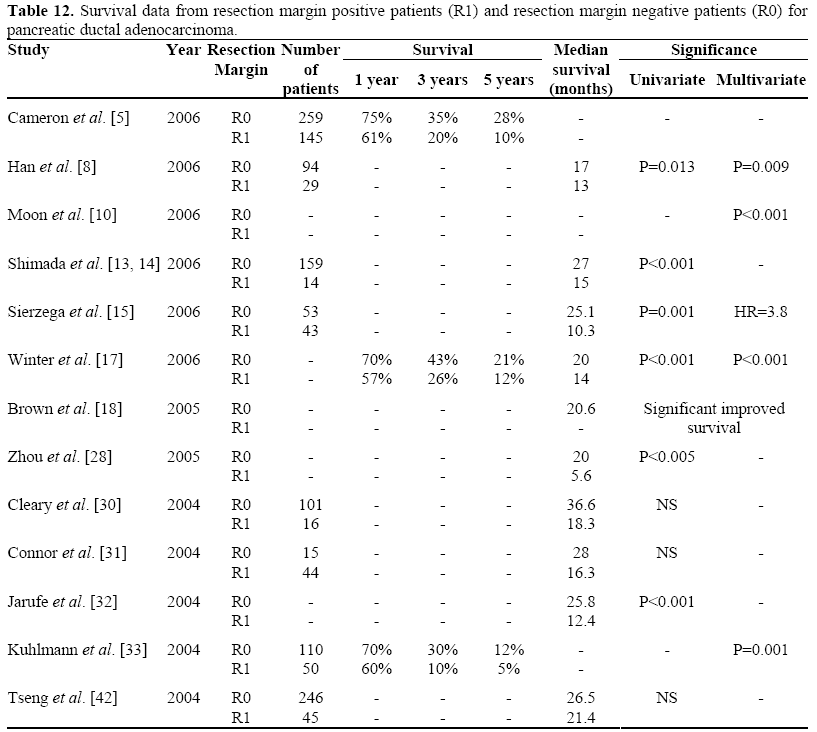
The reasons for this apparent disparity is that pathological handling and reporting of pancreatic specimens, at present, varies widely and guidelines issued by professional bodies lack detailed guidance regarding the assessment of resection margins [187]. These discrepancies in reporting obfuscate comparison of multinational studies. In addition, in many cases positive resection margins may not refer to tumour infiltration at the transection point across pancreatic tissue, bile duct or duodenum but rather to tumour infiltration up to the retroperitoneal tissues, i.e. dissection planes rather than transection margins. These considerations would suggest that resection margin may impact on survival by acting as an indicator of biological aggressiveness rather than being a technical factor which could be influenced by the operating surgeon [188].
Summary
A tumour diameter of less than 2 cm, negative lymph nodes, well-differentiated tumours and a negative resection margin would appear to be highly significant factors in determining prolonged survival following pancreatic cancer surgery. Individual studies also demonstrate that perineural and microvessel invasion are important prognostic factors, but this association is only weakly supported by meta-analysis of the current data. Resection margin and tumour diameter are probably indices of aggressive tumour phenotype rather than being directly causative for poor survival after surgery. Of these entire tumour characteristics reviewed, only tumour diameter can reliably be predicted preoperatively, the remainder being histopathological considerations following resection.
There have been considerable advances in the management of pancreatic cancer and centralisation of services has had a major impact on post-operative mortality and a modest increase in long-term survival. While the impact of chemotherapy and radiotherapy has not been assessed by this study, neoadjuvant therapy has also impacted significantly on the outcome following resection of pancreatic cancer. Until recently, no general consensus regarding the most appropriate regimen has been reached. This was predominantly due to a lack of adequately powered trials. A meta-analyses of five randomized controlled trials, from 1985 to 2004, investigating the roles of chemoradiation and chemotherapy revealed a 25% significant reduction in the risk of death following adjuvant treatment [189]. The most notable prospective study to date is the ESPAC-1 trial which has indicated a significant positive impact on long-term survival with chemotherapy with chemotherapy having a detrimental effect on survival [190]. Thus the current standard of care for pancreatic cancer is curative surgery followed by adjuvant systemic chemotherapy. Chemoradiation may yet have a role to play in patients with positive resection margins, but this remains to be determined [191].
However, it is a sobering thought that, excluding blood transfusion, tumour characteristics remain the only significant features influencing survival after pancreatic cancer surgery. Apart from tumour size, assessment of these criteria can only be made histopathologically and do not appear to be amenable to pre-operative or intraoperative manipulation. It remains to be seen whether new imaging modalities such as endoscopic ultrasound may allow better assessment of factors such as lymph node involvement. In light of these data, it could be reasoned that that tumour size, on cross-sectional imaging, might be employed as means of selecting the most appropriate candidates for surgery, in cases where the risks of resection are high.
The authors have no potential conflicts of interest